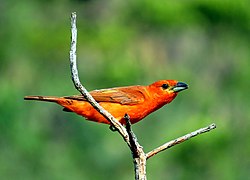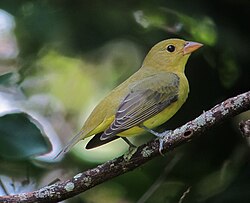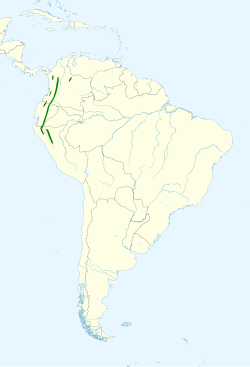| Common name | Scientific name and subspecies | Range | Size and ecology | IUCN status and estimated population |
|---|
| Flame-colored tanager 
Male

Female | Piranga bidentata
Swainson, 1827
- P. b. bidentata
- P. b. flammea
- P. b. sanguinolenta
- P. b. citrea
| Mexico, and throughout Central America to northern Panama
 | Size:
Habitat:
Diet: | LC
|
|---|
| Red-headed tanager 
Male
| Piranga erythrocephala
(Swainson, 1827) | Mexico
 | Size:
Habitat:
Diet: | LC
|
|---|
| Hepatic tanager 
Male

Female | Piranga hepatica
Swainson, 1827
- P. h. hepaticaSwainson, 1827
- P. h. dextraBangs, 1907
- P. h. figlinaSalvin & Godman, 1883
- P. h. savannarumT.R. Howell, 1965
- P. h. albifaciesJ.T. Zimmer, 1929
| Southwestern United States (Arizona, New Mexico, and locally in southern California and Colorado), Mexico & Central America
 | Size:
Habitat:
Diet: | LC
|
|---|
| Tooth-billed tanager 
Male

Female | Piranga lutea
(Lesson, 1834)
- P. l. testaceaP.L. Sclater & Salvin, 1868
- P. l. facetaBangs, 1898
- P. l. haemaleaSalvin & Godman, 1883
- P. l. toddiParkes, 1969
- P. l. desidiosaBangs & Noble, 1918
- P. l. lutea(Lesson, 1834)
| northwestern South America
 | Size:
Habitat:
Diet: | LC
|
|---|
| Red tanager 
Male

Female | Piranga flava
(Vieillot, 1822)
- P. f. macconnelli C. Chubb, 1921
- P. f. rosacea Todd, 1922
- P. f. saira (von Spix, 1825)
- P. f. flava (Vieillot, 1822)
| eastern South America
 | Size:
Habitat:
Diet: | LC
|
|---|
| White-winged tanager 
Male

Female | Piranga leucoptera
Trudeau, 1839
- P. l. leucoptera
- P. l. latifasciata
- P. l. venezuelae
- P. l. ardens
| Belize, Bolivia, Brazil, Colombia, Costa Rica, Ecuador, El Salvador, Guatemala, Guyana, Honduras, Mexico, Nicaragua, Panama, Peru, and Venezuela
 | Size:
Habitat:
Diet: | LC
|
|---|
| Western tanager 
Male

Female | Piranga ludoviciana
(Wilson, 1811) | Southeastern Alaska south to northern Baja California, Mexico. Western tanagers extend east to western Texas and north through central New Mexico, central Colorado, extreme northwest Nebraska, and areas of western South Dakota to southern Northwest Territories, Canada
 | Size:
Habitat:
Diet: | LC
|
|---|
| Scarlet tanager 
Male

Female | Piranga olivacea
(Gmelin, 1789) | Eastern United States. Migrate to Central and northern South America
 | Size:
Habitat:
Diet: | LC
|
|---|
| Rose-throated tanager 
Male
| Piranga roseogularis
Cabot, 1846
- P. r. roseogularis
- P. r. tincta
- P. r. cozumelae
| Belize, Guatemala, and Mexico
 | Size:
Habitat:
Diet: | LC
|
|---|
| Summer tanager 
Male

Female | Piranga rubra
(Linnaeus, 1758)
- P. r. cooperi Ridgway, 1869
- P. r. rubra (Linnaeus, 1758)
| Southern United States, extending as far north as Iowa. These birds migrate to Mexico, Central America and northern South America
 | Size:
Habitat:
Diet: | LC
|
|---|
| Red-hooded tanager  | Piranga rubriceps
Gray, 1844 | Colombia, Ecuador, and Peru
 | Size:
Habitat:
Diet: | LC
|
|---|






























